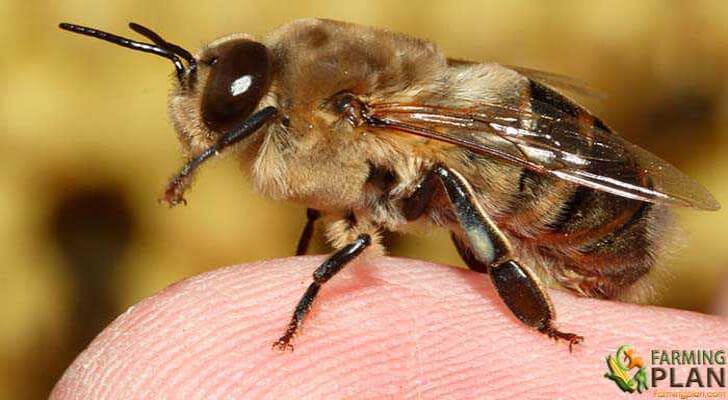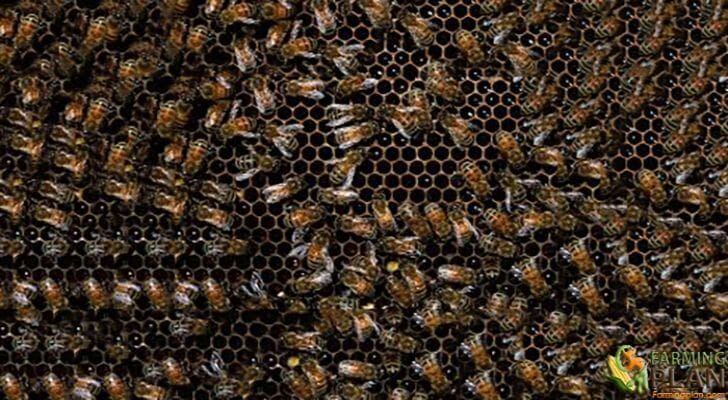A drone bee is a male honeybee. Unlike the female worker bees, drones do not have stingers and are unable to gather nectar or pollen on their own since they cannot feed without assistance from workers. A drone’s only role in life is to mate with an unfertilized queen-to produce offspring that carry 50% of his genes each time he does so.
Drones carry only one allele at each chromosomal position because they are haploid, containing a single set of chromosomes from the mother. During development within a queen, diploid cells divide to generate gametes with 16 chromosomes – resulting in an egg that has new alleles for various loci. This process is called simply arrhenotoky. In other words, males can’t reproduce offspring without female help.

Characteristics of Drone Bee
The drone bee is, so to speak, the father of all the bees in the hive. But he dies when he impregnates the mother, the queen bee. It is estimated that in a healthy hive, there must be about 200 drones, not much more nor any less. The drones bee do not work for the hive because they lack the tools to do so.
The reason is a mere biological question since its purpose is the fecundation of the queen and the continuity of the species. At one time, it has to offer the bee queen millions of fertilizing elements. So that drones must be strong beings and eaters. It is estimated that each day, each drone eats the daily production of six bees.
The eggs that will later produce drones have not been previously fertilized. Therefore they have half of the genetic endowment of the species. The drones do not collect nectar or pollen. They do not intervene in the harvesting of nectar, in the elaboration of honey or in the defense of the hive, since they do not have a sting.
They eat the honey made by many workers and sleep, therefore, in times of drought or when food is scarce (usually late autumn, early winter). The workers are responsible for eliminating them by not letting them enter the hive, so they die of hunger and cold.
The beekeeper is also responsible for this task. To eliminate them when there is too much, the “Alley trap” is placed. Which consists of a grid placed in the entrance through which only the workers can pass, and the drones, because of their bigger size they are trapped or they can not enter.
The main purpose of the drones is to fertilize the new queen. These copulate with the queen in mid-flight. After the copula is finished, the drone dies. The queen bee copulates with several drones on the various fertilization flights. The drones do not have a sting since the sting is actually a modified egg container.
The drones are half brothers with the workers and with the queen. In beekeeping genetics, the drones are the result of an unfertilized egg. That is, the fertilized queen has the possibility of deciding to lay eggs, fertilized by the male or without fertilization by the male. You may also like to read Worker Bee.
Therefore the queen and workers are the results of an egg fertilized by the male and them. They have no father, they give only daughters and grandchildren of them. Because the queen and workers are the results of a fertilized egg, they receive 50% of each parent.
If daughters are born queens or workers of her, the drones that fertilized if they are the father of them. A drone son of an “egg-laying” worker, daughter of this queen, this laying-worker would have the genes of both parents.
And if he, in turn, copies 100% of it, then copies 50% of both progenitors and controlled genetics went “to Molina”. To these drones, the sons of laying workers, we call them “bastard drones” since they do not carry 100% of the maternal genes.
And the paternal genes could be varied and not necessarily coincide in all cases. It is difficult to predict with which and how many drones a queen bee will cross during her nuptial flight. While the drones are born from the queen’s eggs, this means that the queen produces drones without the need to mate.
Food
Drone bee is fed by beekeepers as follows 1 kg. Of sugar, 1 liter of water and 100 grams of pollen.
Usage
The drones bee then have two reproductive functions:
- First: They convert and extend the female gamete of the queen to about 10 million identical male gametes.
- Second: They serve as a vehicle to move the gametes propagated to the queen.
In the reproduction of the bee, then, the female progeny receives a gamete from the queen who produced the egg and the other gamete from another queen. Thus, a bee pedigree only contains females and only females need to be recorded. You may also like to read Honey Bee Life Cycle.
Special Feature
There are many myths about the drone bee. It was always claimed that the drone was the queen’s son, when the reality is that he is genetically the queen’s brother, as part of a biological unit that has been wrongly referred to as an egg.
Since to be an egg should contain the genetic information of two parents and is actually an egg form from meiosis of the queen’s cells. It is incorrect to say that the drone is born of an infertile egg because, in reality, it is neither an egg nor an infection.
We could call her mother sister. The drone has no son, only grandchildren; he has no father has the only mother and his hereditary factors correspond to those of his grandparents. The drones are born from an egg and have half of chromosomes 16 and their sperms also have 16 chromosomes, therefore, repeat the genetic characteristics of the egg that spawned it.
Because the drones come from an egg, the bee’s pedigrees are different. In the case of the bee, the drone has only his mother, two grandparents, three bis-grandparents and only five grandparents. You may also like to read Queen Bee.
FAQ
What is a drone bee?
Drone bees, or male honey bees, are an important part of a honey bee colony. They typically live for between 8 to 12 days and usually die shortly after mating with the queen bee. During their short life, drones play an essential role in the health of the hive by enabling it to reproduce through successful mating with the queen.
How many eyes does a drone bee have?
A drone bee, or male honeybee, has two compound eyes and three simple eyes. The compound eyes are made up of thousands of tiny lenses called ommatidia that give the drones high-resolution vision to help them find mating opportunities with receptive queens. Each simple eye – also known as a stemmata – located on either side of the drone’s head gives him some peripheral vision, allowing him to monitor the movement of other bees in its environment. While this may seem like the perfect set up for an advanced level surveyor, scientists have recently discovered that drones can only see in black and white due to their lack of color receptors found in their ommatidia! This leaves them unable to differentiate certain shapes and patterns based on color alone – a huge disadvantage compared to worker bees who are able to distinguish reds from blues and greens from yellows.
Do drone bees have stingers?
The short answer to this question is yes, drone bees do have stingers. To understand why and how, it is important to first explain the differences between worker bees (typically female) and drones (typically male). Worker bees are responsible for tending to the colony by collecting food, maintaining the hive, and caring for the queen bee. Drones on the other hand mainly serve as mating partners for virgin queens during mating season. This means that drones don’t usually spend their time inside of a hive or even in a colony like workers do; instead they fly from one location to another looking for mates before returning back home after they have successfully mated with a queen.
Conclusion
If you are not familiar with the drone bee, then you will be after reading this article. Drones do not have stingers and are unable to gather nectar or pollen on their own since they cannot feed without assistance from workers. A drone’s only role in life is to mate with an unfertilized queen-to produce offspring that carry 50% of his genes each time he does so. Hope this guide has helped you! Good luck
As a reference: Wikipedia


